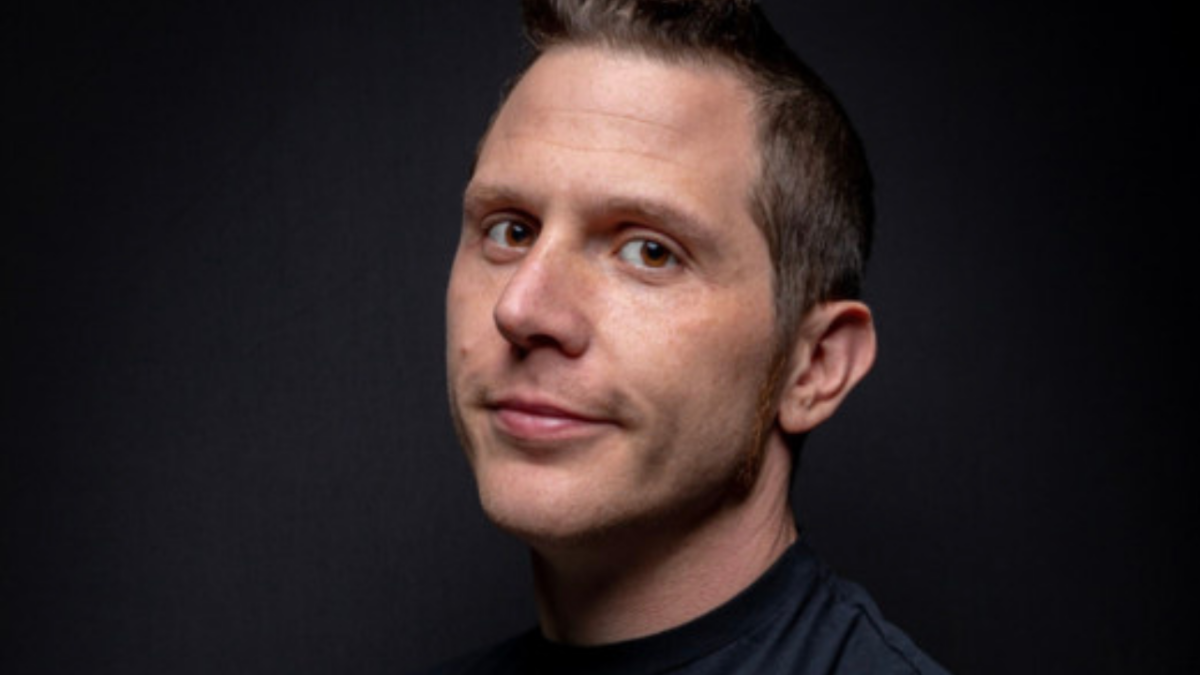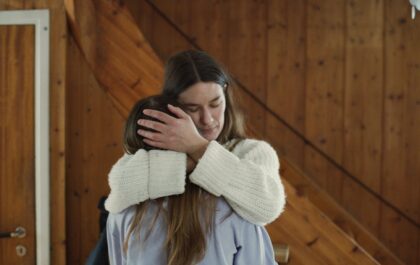Op 29 oktober kan je op Razor Reel Flanders Film Fest de onafhankelijke psychologische horrorfilm Black Mold bekijken. Voor de gelegenheid nam Regisseur John Pata uitgebreid de tijd om met ons te corresponderen. Het resultaat is een boeiend interview waarin hij ondermeer spreekt over angst, psychische kwetsbaarheid en wasbeerstront.
De hoofdpersonen in de film hebben een eigenaardige hobby: ze fotograferen verlaten gebouwen. Is dit een hobby die je deelt met de personages?
Ja, dat is zo. Ik ben altijd op zoek naar verlaten gebouwen als ik op reis ben en stop waar ik kan om ze te fotograferen. Er zit echt een gevoel van schoonheid aan dit soort gebouwen, een gevoel dat ik nergens anders ervaar. Begrijp me niet verkeerd, een schilderachtige zonsondergang met bomen, bergen en water is erg mooi, maar er is iets met een afbrokkelend en vergeten gebouw dat me echt aanspreekt.
Aan het begin van de film komen de personages vreemde voorwerpen tegen. Gebeurt dit vaak in het echt? Wat was je vreemdste ervaring tijdens het verkennen van deze verlaten gebouwen?
Ik kom altijd vreemde en interessante voorwerpen tegen tijdens het verkennen. De meeste voorwerpen en vondsten uit de eerste twee huizen in de film zijn gebaseerd op mijn eigen ervaringen. Ik vond weldegelijk een religieus standbeeld zonder hoofd, waarvan ik dacht dat het Jezus was en schreef het in het script. Ik stuurde Tiffany Jasinski, onze art director, mijn foto ter referentie en zij vertelde me dat het niet Jezus was, maar eerder Petrus, geloof ik. Hoe dan ook, we hielden het op Jezus voor de film.
Bij één huis was de tweede verdieping bedekt met romannetjes. En dan bedoel ik ook echt helemaal vol – in de gang en de meeste kamers lagen boeken op de grond. Ik ging een slaapkamer binnen en realiseerde me niet eens dat ik op het bed zelf stond omdat de boeken niet alleen zo hoog waren als het bed, maar het ook bedekten. Ik kon er maar niet over uit hoeveel boeken er waren en hoe ze daar allemaal terecht waren gekomen. Het was echt een bizarre ervaring.
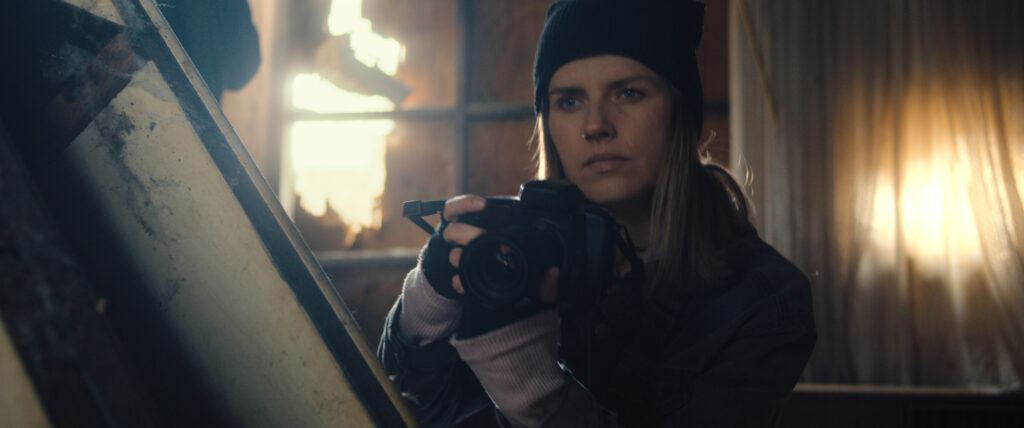
Over verlaten gebouwen: Black Mold speelt zich grotendeels af in een verlaten instelling. Hoe was het om op deze locatie te filmen? Hadden jullie zelf niet veel last van schimmel?
Er was zeker schimmel op onze locaties, maar het echte probleem was wasberenstront. De tweede verdieping van het eerste huis waar Brooke en Tanner naartoe gaan in het begin van de film zat echt onder de wasberenstront. Ik bedoel centimeters wasberenstront. We hadden het schoongemaakt voordat we daar gingen filmen, maar ze deden zo hun best om alle poep te verwijderen dat we de vloeren zelf moesten vuilmaken omdat het te schoon was.
De locaties bleken net zo uitdagend te zijn als we hadden verwacht, zo niet meer. Er waren duidelijke logistieke problemen waar we ons vanaf het begin bewust van waren; geen stroom, geen verwarming, geen water, en dat waren enorme uitdagingen om mee om te gaan. De personages komen terecht in Franklin Hill, het grote instituut waar je het over hebt, wat eigenlijk drie gebouwen waren die we hebben gefilmd en die in de film als één gebouw worden gepresenteerd. Vanwege de logistieke beperkingen waar we mee te maken hadden, hadden we een behoorlijk grote productievloot die met ons mee moest verhuizen (onze stroom, water, badkamers, etc.), dus we moesten ons schema goed plannen voor efficiëntie. Ons productieteam deed ongelooflijk werk en zorgde echt voor ons.
Je kan je niet voorstellen hoe alle kleine dingen die ineens ingewikkelder worden. Je moet je handen wassen en ook al is er een toilet aan de overkant van de gang, je moet door een enorm gebouw lopen om buiten bij het mobiele toilet te komen. Je opent net een blikje water en je wilt hem neerzetten, maar er vallen isolatiescherven uit het plafond. Je moet het licht aandoen in een kamer op de tweede verdieping, maar er is geen licht om aan te doen, dus het grip team moet helpen. Voor de cast moesten we ervoor zorgen dat ze tussen de opnames door nooit tegen een muur leunden omdat ze dan onder het stof zouden zitten. De lijst gaat maar door.
Toen we aan de productie begonnen, vertelden we iedereen dat dit geen luxe opname zou worden en dat was het zeker niet.
De film ziet er opvallend sfeervol uit. Hoe zijn jullie tot de visuele flair van de film gekomen? Was dat niet moeilijk in zo’n kil gebouw?
Alles was moeilijk in zo’n kil gebouw, maar dat maakte het nog spannender! (lacht)
Bedankt voor het opmerken van de sfeer, daar hebben we hard aan gewerkt. Director of photography Robert Patrick Stern en ik hebben het meer dan een jaar voor de opnames uitgebreid gehad over de look en feel van deze film. Het was belangrijk voor me om deze locaties niet alleen als iets griezeligs, maar ook als iets moois te presenteren. Rob wilde de beelden graag benaderen als een fotograaf, we gebruikten oude filmlenzen uit de jaren zeventig om die mentaliteit te omarmen en het was niet ongewoon dat hij tegen me zei: “Hoe zou je dit fotograferen?”. Maar de locaties hadden hun eigen inherente sfeer door de omstandigheden waarin ze zich bevonden, dus het ging er meer om dat we ervoor zorgden dat onze aanpak ze aanvulde in plaats dat ze er van wegnam. We hebben er ook goed op gelet om de camera soepel en vergrendeld te houden om op bepaalde momenten een gevoel van rust te geven en dan over te schakelen op handheld als de dingen uit de hand beginnen te lopen.
De audiokant is ook absoluut belangrijk voor de sfeer van de film. Wat onze componist Nicholas Elert en het geluidsteam van Periscope Post & Audio hebben gemaakt, is een goede aanvulling op wat we met de camera hebben gedaan.
Je bent schrijver, monteur en regisseur. Dat is veel creatieve vrijheid, maar ook veel verantwoordelijkheid en veel werk. Hoe heb je dit kunnen combineren? Welke impact had dit op de film en op jou?
Ik zie schrijven, regisseren en monteren als synoniemen van elkaar. Als ik schrijf, denk ik aan de montage. Als ik regisseer, kan ik het schrijven en montage gebruiken wanneer dat nodig is, wat vaak het geval kan zijn. En ik denk dat het helpt als ik met de acteurs werk. Ik kan met ze praten in alle drie de rollen en alle vragen beantwoorden die ze hebben. Hoe goed je je ook voorbereidt, hoeveel je ook plant, toch zijn er altijd onverwachte variabelen die opduiken tijdens het filmen. Ze kunnen jou, het verhaal en de productie echt op het verkeerde been zetten en vaak moet je heel snel beslissingen nemen om het hoofd boven water te houden. De schrijver, editor en regisseur zijn kan een enorm voordeel zijn omdat ik ze alle drie tegelijk kan raadplegen en op dat moment de best geïnformeerde beslissing kan nemen.
Maar het kan ook vermoeiend zijn. Als je door de productie heen bent, ben je uitgeput en dan moet je snel daarna in de montage duiken. Het kan zeker alles verterend zijn, maar ik ben veel beter geworden in het stellen van grenzen zodat het niet zelfdestructief is.
In de film heeft een van de personages het over zijn -ik citeer- “domme” angst voor vogelverschrikkers. Wat is jouw “domme” angst”?
Waterlichamen. Ik ben niet bang om te verdrinken, ik kan zwemmen, ik ben bang voor wat er onder me kan zitten. Dit is waarschijnlijk geen verrassing, maar het komt doordat ik Jaws heb gezien toen ik zes was en er sindsdien mijn hele leven naar heb gekeken. En het belachelijke is dat deze angst pas echt begon toen ik twintig was. Sindsdien krijg je me niet meer in het water. Ik ga zelfs bijna niet in zwembaden. Ik woon niet eens in de buurt van de oceaan, bij mij is het allemaal zoet water, dus vrienden zullen altijd zeggen: “Er zijn geen haaien in het meer/de vijver/de rivier.” Dat is waar, misschien niet, maar er kan ook iets anders zitten waar we ons niet eens bewust van zijn en daarom ga ik er niet in.
Ook de bloedzuigerscène in Stand By Me heeft me als kind verkloot. Er zijn te veel gevaren in water, ik ben goed op het land.
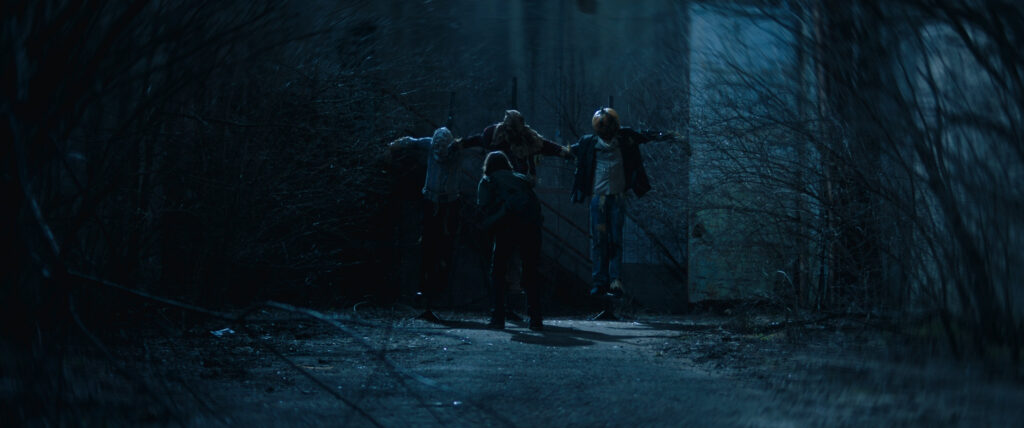
Een belangrijk thema in de film is geestelijke gezondheid. In eerdere interviews over de film heb je al uitgebreid verteld hoe persoonlijk de film en zijn thema’s voor jou waren. Als er iets is dat je zou willen vertellen aan kijkers die worstelen met hun geestelijke gezondheid, welke boodschap zou dat dan zijn?
Dank je, dit is een ongelooflijke en belangrijke vraag. Ik kan niet zeggen hoe het in België is, maar er heerst zo’n stigma rond geestelijke gezondheid in de Verenigde Staten, vooral als het om mannen gaat. Er is de laatste jaren verandering gekomen, het gesprek groeit en verandert, maar dat stigma is nog steeds erg sterk en overheersend, en ik waardeer het echt dat je het gesprek hier brengt.
Als je worstelt met je geestelijke gezondheid, dan snap ik dat. Ik weet hoe het is en het is klote. Ik weet ook dat als je er echt mee zit, het makkelijk is om te denken dat het niet anders kan, maar dat kan wel. Ik weet dat het makkelijk is om het gevoel te hebben dat het te veel werk is, en het is zeker veel werk, maar het is het waard. Jij bent het waard. Kijken naar het grote geheel kan intimiderend zijn, denken aan waar je wilt staan kan voelen als te veel, dus begin klein. Stel jezelf kleine doelen die haalbaar zijn. Als je de middelen hebt om met een therapeut te praten, raad ik je sterk aan om dat te doen. Ik ben nu bijna zeven jaar in therapie en het is zo’n positieve, lonende ervaring geweest. Ik moet nog steeds veel werken aan mezelf, maar ik ben al een heel eind gekomen. Als je niet de middelen hebt om met een therapeut te praten, zoek dan iemand in je leven tegen wie je helemaal eerlijk kunt zijn en praat met hem of haar. Als je dat niet kunt of wilt, schrijf het dan op papier. Wat het ook is, gooi het er gewoon uit. Het is cliché om te zeggen, maar het heeft zoveel voordelen om gewoon te zeggen wat je voelt, of het nu met je stem is of op papier.
Mensen denken geen twee keer na over het verzorgen en trainen van hun lichaam, dus waarom zouden onze hersenen anders zijn? Mensen maken tijd vrij om naar de sportschool te gaan, wij kunnen en moeten hetzelfde doen voor onze hersenen.
Wat brengt de toekomst voor jou? Is er een nieuw project in het verschiet?
Ik weet echt niet wat de toekomst in petto heeft. Ik heb meerdere scripts geschreven en een enorme hoeveelheid andere ideeën uitgewerkt of in mijn hoofd, en ik zou graag de kans krijgen om weer te regisseren, maar er zat negen jaar tussen Black Mold en het laatste dat ik regisseerde (een shortfilm genaamd Pity). Ik kan er niet van uitgaan dat er nog een project komt omdat er zoveel factoren zijn, maar ik hoop absoluut van wel.
Tot slot: Razor Reel valt in de periode van Halloween. Welke film ga jij kijken met Halloween?
Mijn favoriete Halloweenfilm is Trick ‘r Treat, ik vind het echt een perfecte Halloweenfilm die alles heeft wat je zou willen in een film waarin Halloween centraal staat, maar ik kijk hem niet elk jaar omdat ik mezelf er niet aan wil verbranden. Ik ben ook een grote fan van Murder Party, dus misschien moet ik die dit jaar maar eens kijken omdat die zich ook afspeelt op Halloweenavond.
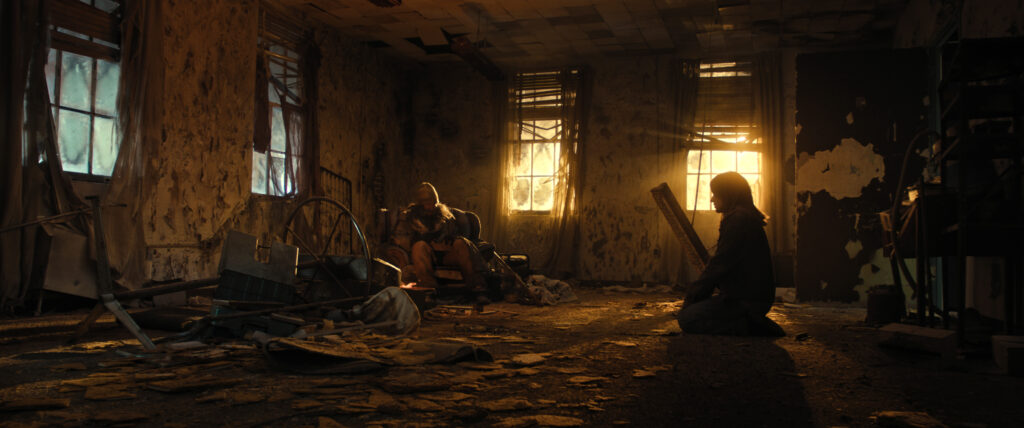
Dit artikel is vertaald vanuit het engels. Hieronder kan je de originele tekst vinden:
The main characters in the film have a peculiar hobby: they photograph abandoned buildings. Is this a hobby you share with the characters?
It is. I’m always on the lookout for abandoned buildings when I’m on a road trip and will stop to photograph them whenever I can. There’s a real sense of beauty to these types of buildings, one I can’t say I experience elsewhere. Don’t get me wrong, a picturesque sunset with trees and mountains and water is very pretty, but there’s something about a crumbling and forgotten building that really speaks to me.
At the beginning of the movie, the characters encounter some strange objects. Does this happen often in real life? What was your strangest experience when exploring these abandonned buildings?
I always come across strange and interesting objects while exploring. Most of the objects and beats from the first two houses are based on my own experiences. I did find a headless religious statue, which I thought was Jesus and wrote it in the script. I sent Tiffany Jasinski, our art director, my photo for reference and she told me it wasn’t Jesus but rather St. Peter, I believe. Either way, we kept it as Jesus for the film.
At one house, the second floor was covered with trashy romance novels. And I mean COVERED – at least two feet worth of books piled on the floor throughout the hallway and most of the rooms. I entered a bedroom and didn’t even realize I had been standing on the bed itself because the books were not only as high as the bed, but also covered it. I just couldn’t get over how many books there were and they all got up there in the first place. It was a truly bizarre experience.
About abandoned buildings: Black Mold is largely set in an abandoned institution. What was it like to film in this location? Didn’t you guys have a lot of mold problems yourselves?
There was mold in our locations, sure, but the real problem was raccoon shit. The second floor of the first house Brooke and Tanner go to in the beginning of the film was truly covered in raccoon shit. I mean inches of raccoon shit. We had it cleared out before we shot in there, but they did such a good job removing all the poop, we then had to dirty the floors ourselves because it was too clean.
The locations proved to be challenging as we expected to be, if not more. There were obvious logistical issues we were aware of from the start; no power, no heat, no water, and those were massive challenges to deal with. The characters end up at Franklin Hill, the large institution you speak of, which was actually three buildings we shot at and presented as one in the film. Because of the logistical limitations we were up against, we had a pretty substantial production fleet that had to move with us (our power, water, bathrooms, etc), so we had to plan out our schedule really well for efficiency. Our production team did an incredible job and truly took care of us.
You don’t even realize all the little things that suddenly become more complicated. You need to wash your hands, and even though there’s a bathroom right across the hall, you have to walk through a massive building to get outside to the mobile bathroom. You just open a can of water and you go to set it down, but there’s insulation fragments falling from the ceiling. You need to turn on a light in a room on the second floor, but there is no light to turn on so the G&E team have to help out. For the cast, we had to make sure they never leaned up against a wall in between takes because they’d be covered in dust. The list goes on.
Heading into production, we told everyone this was not going to be a glamorous shoot and it most certainly was not.
The film looks remarkably atmospheric. How did you arrive at the film’s visual flair? Wasn’t this difficult in such a chilly building?
Everything was difficult in such a chilly building, but that’s what made it even more thrilling! Haha.
Thank you for noting the atmosphere, that’s something we worked very hard to achieve. Director of photography Robert Patrick Stern and I talked about the look and feel of this film at great lengths for over a year before we shot. It was important to me to not just present these locations as something creepy but also beautiful. Rob was keen on approaching the visuals like a photographer would, we used old film lenses from the 1970s to embrace that mindset and it wasn’t uncommon for him to say to me, “How would you photograph this?” But the locations came with their own inherent atmosphere due to their conditions, so it was more about making sure our approach complimented rather than take away from them. We also were very mindful to keep the camera smooth and locked down up to give a sense of ease at specific moments and then switch to handheld when things start to unravel.
The audio side of things is absolutely instrumental to the atmosphere of the film too. What our composer Nicholas Elert and the sound team at Periscope Post & Audio created compliment what we did with the camera so well.
You’re a writer, editor and director. That’s a lot of creative freedom, but also a lot of responsibility a lot of work. How were you able to combine this and what impact did it have on the film and on you as a person?
I think of writing, directing, and editing being synonymous with each other. When I’m writing, I’m thinking about the edit. When I’m directing, I can tap into the writing and editing when needed, which can be pretty often, and I think it helps when working with the actors. I can speak to them in all three roles and answer whatever questions they might have. No matter how prepared you are, how much you plan out, there are always unexpected variables that pop up when filming. They can really set you and the story/production off-course, and oftentimes, you have to make really quick decisions to stay afloat. Being the writer, editor, and director can be a huge advantage because I can consult all three at the same time and make the best informed decision in the moment.
It can be tiring too, though. When you get through production, you’re exhausted and then you have to dive into the edit soon after. It certainly can be all-consuming, but I’ve gotten much better about setting boundaries so it’s not self-destructive.
In the film, one of the character talks about his -I quote- “stupid” fear of scarecrows.
What is your “silly” fear”?
Bodies of water. I’m not afraid of drowning, I know how to swim, I’m afraid of what might be underneath me. Probably no surprise here, but this is the result of seeing Jaws at the age of six and then watching it for my entire life since. And the ridiculous thing is that this fear didn’t really set in until I was twenty. Ever since then, you cannot get me in a body of water. I hardly even go in pools. I don’t even live near the ocean, it’s all fresh water by me, so friends will always say, “There are no sharks in the lake/pond/river.” That’s true, there might not be, but there might be something else we’re not even aware of and that’s why I stay out of it.
Also, the leeches scene in Stand By Me really fucked me up as a kid too. There are too many potentials in water, I’m good on land.
The film deals with mental health. In previous interviews about the film, you already talked at length about how personal the film and it’s themes were for you. If there were anything you would want to tell viewers struggling with their mental health, what message would it be?
Thank you, this is an incredible and important question. I can’t speak on how it is in Belgium, but there is such a stigma around mental health in the United States, especially when it comes to men. There’s been a change in recent years, the conversation is growing and changing, but that stigma is still very strong and prevalent, and I really appreciate you bringing the conversation here.
If you’re struggling with your mental health, I get it. I know how it is and it sucks. I also know that when you’re really in it, it’s easy to think things can’t be different, but they can be. I know it’s easy to feel like it’s too much work, and it certainly is a lot of work, but it’s worth you. You are worth it. Looking at the big picture can be intimidating, thinking of where you want to be can feel like too much, so start small. Set yourself small goals that are manageable. If you have the means to talk to a therapist, I strongly encourage you to do so. I’ve been in therapy for almost seven years now and it’s been such a positive, rewarding experience. I still have more work to do, but I’ve come a really long way. If you don’t have the means to talk to a therapist, find someone in your life you can be totally honest with and talk to them. If you can’t do that or don’t want to, write it out on paper. However it is, just get it out. It’s cliche to say, but there is such a benefit from just saying what you’re feeling, whether it’s with your voice or your handwriting.
People don’t think twice about taking care of and exercising their bodies, so why should our brains be any different? People will carve out time to go to the gym, we can and should do the same for our brains.
What does the future hold for you? Is there a new project on the horizon?
I really don’t know what the future holds. I have multiple scripts written and a vast amount of other ideas outlined or in my head, and I would love the opportunity to direct again, but it was nine years between Black Mold and the last thing I directed (a short film called Pity). I can’t assume there will be another project because there are so many factors but I sure as hell hope there is.
To conclude: Razor Reel falls during the period of Halloween. What movie will you be watching on Halloween?
My favorite Halloween movie is Trick ‘r Treat, I think it’s a truly perfect Halloween film that has everything one would want in a Halloween-centered movie, but I don’t watch it every year because I don’t want to burn myself out on it. I’m also a big fan of Murder Party, so I might have to pop that one in this year instead since it also takes place on Halloween night.



